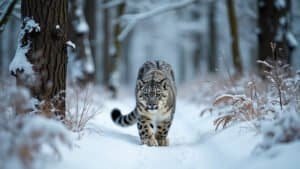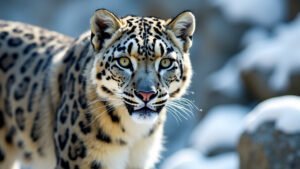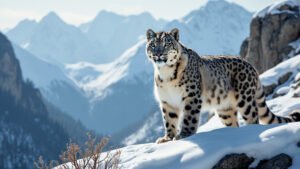Introduction
Studying snow leopard populations is essential for their conservation, and genetic markers play a crucial role in this research. These markers help scientists understand population structures, genetic diversity, and gene flow among different populations of snow leopards
This article will explore the key genetic markers used in snow leopard studies, such as microsatellites, mitochondrial DNA, and SNPs. It will also discuss how these samples are collected and analyzed, the challenges researchers face, and how genetic diversity impacts conservation strategies
Finally, we’ll look at the technological advancements that are transforming snow leopard genetic research
Primary Genetic Markers in Snow Leopard Research
Understanding the genetic makeup of snow leopards is essential for conservationists aiming to protect this elusive species. Genetic markers are segments of DNA used to track variations within a population, offering insights into genetic diversity, population structure, and gene flow
In snow leopards, several genetic markers are commonly used, including microsatellites, mitochondrial DNA (mtDNA), and single nucleotide polymorphisms (SNPs). Each of these markers serves a specific purpose in understanding the genetic health and connectivity of snow leopard populations across their vast and fragmented habitats
Role of Microsatellites in Population Studies
Microsatellites, also known as simple sequence repeats (SSRs), are short, repetitive sequences of DNA scattered throughout the genome. They are highly polymorphic, meaning they vary greatly between individuals, making them particularly useful for population genetic studies
In snow leopard research, microsatellites are used to assess genetic diversity within populations and to measure gene flow between different groups. This information is crucial for determining the level of inbreeding within a population, which can have serious implications for its long-term viability
For example, a study conducted by Sharma et al. (2014) used microsatellites to analyze snow leopard populations in the Indian Himalayas. The study found that while some populations exhibited high genetic diversity, others were more isolated and showed signs of inbreeding
These findings highlighted the need for wildlife corridors to facilitate gene flow between isolated populations, which is vital for maintaining their genetic health
Understanding Mitochondrial DNA in Snow Leopards
Mitochondrial DNA (mtDNA) is another important genetic marker used in snow leopard studies. Unlike nuclear DNA, which is inherited from both parents, mtDNA is inherited only from the mother
This unique inheritance pattern makes mtDNA an excellent tool for studying maternal lineages and understanding the evolutionary history of populations
In snow leopards, mtDNA analysis has been used to investigate the genetic structure of populations across their range, from the Himalayas to the Altai Mountains. One significant study by Janečka et al. (2017) analyzed mtDNA from snow leopards across multiple countries, revealing distinct genetic lineages that correspond to different geographical regions
This information is essential for identifying population units that are critical for conservation, as it helps to ensure that conservation efforts are appropriately targeted to preserve the unique genetic makeup of snow leopard populations
Application of SNPs in Genetic Research
Single nucleotide polymorphisms (SNPs) are the most common type of genetic variation found within a species’ DNA
They represent a change in a single nucleotide—a building block of DNA—at a specific position in the genome. SNPs are highly informative markers that can be used to study fine-scale genetic differences between individuals and populations
In snow leopards, SNPs have been used to gain a deeper understanding of population structure and to track changes in genetic diversity over time. With advancements in sequencing technologies, it is now possible to analyze thousands of SNPs simultaneously, providing a detailed picture of the genetic landscape
A study by Kitchener et al. (2020) utilized SNP analysis to examine the genetic diversity of snow leopards in Central Asia. The findings revealed low genetic diversity in some regions, underscoring the need for immediate conservation interventions to prevent further loss of genetic variability
Collection and Analysis of Genetic Samples
The collection and analysis of genetic samples from snow leopards are critical steps in understanding their population genetics and informing conservation strategies
Given the elusive nature of snow leopards and the harsh, remote environments they inhabit, researchers often rely on innovative and non-invasive techniques to gather DNA samples
These methods, along with sophisticated laboratory analyses, allow scientists to study the genetics of snow leopards without needing to capture or disturb these endangered animals
Techniques for Collecting Non-Invasive Samples
One of the most common and effective methods for collecting snow leopard DNA is through non-invasive sampling. This approach involves gathering samples that the animals naturally leave behind, such as fur, scat (feces), and urine
Scat samples are particularly valuable because they can provide not only DNA but also information about the snow leopard’s diet and health
Field researchers often traverse the rugged terrain of snow leopard habitats, searching for these signs. Once found, scat samples are carefully collected and stored in sterile containers to prevent contamination
These samples are then transported to laboratories where DNA is extracted for analysis. Non-invasive sampling is highly advantageous because it minimizes the stress on the animals and reduces the risk of human-wildlife conflict
For instance, a study by Aryal et al. (2016) successfully used scat samples to study the genetic diversity of snow leopards in Nepal. This method allowed researchers to monitor population changes over time without needing to capture the animals, which is both logistically challenging and potentially harmful
Laboratory Methods for Analyzing Snow Leopard DNA
Once collected, the DNA from these non-invasive samples undergoes a series of laboratory processes to be analyzed. The first step is DNA extraction, where genetic material is isolated from the sample
Given the often degraded nature of DNA in scat and fur, specialized techniques, such as the use of polymerase chain reaction (PCR), are employed to amplify specific DNA regions, making them easier to study
After DNA amplification, scientists use various genetic markers to analyze the DNA. Microsatellites, mtDNA, and SNPs are the most commonly analyzed markers, as discussed earlier. These markers can reveal a wealth of information, from identifying individual snow leopards to assessing the genetic diversity within a population
Next-generation sequencing (NGS) is another powerful tool used in snow leopard genetic research. NGS allows researchers to sequence entire genomes or large portions of the genome, providing a comprehensive view of the genetic variation within a population
This technology has revolutionized wildlife genetics by enabling detailed and large-scale studies that were previously impossible with older methods
Challenges in Snow Leopard Genetic Sampling
Despite the advances in non-invasive sampling and laboratory techniques, several challenges remain in studying snow leopard genetics. One major challenge is the quality and quantity of DNA obtained from non-invasive samples
DNA from scat or fur is often degraded due to environmental conditions, which can complicate the extraction and analysis process. Researchers must be meticulous in their methods to ensure that the DNA they collect is usable
Another challenge is the logistical difficulty of working in snow leopard habitats. These animals live in some of the most remote and inaccessible regions on Earth, such as the high-altitude mountains of Central Asia
Conducting fieldwork in these environments requires extensive preparation, local knowledge, and the ability to endure harsh weather conditions. The time and resources needed to collect samples can be substantial, often limiting the scope of genetic studies
Additionally, the interpretation of genetic data can be complex. Genetic markers can sometimes produce ambiguous results, especially when dealing with small, isolated populations where inbreeding might skew the genetic diversity metrics. Researchers must carefully analyze the data to draw accurate conclusions about population health and structure
Impacts of Genetic Diversity on Snow Leopard Conservation
Genetic diversity is a cornerstone of species survival, particularly for threatened species like the snow leopard
High genetic diversity within a population means a greater variety of genes, which can enhance the population’s ability to adapt to environmental changes, resist diseases, and reduce the likelihood of inbreeding
For snow leopards, understanding and preserving genetic diversity is essential for developing effective conservation strategies
Importance of Genetic Diversity in Population Health
Genetic diversity is critical for maintaining the overall health and resilience of snow leopard populations. When a population has high genetic diversity, it possesses a wider range of alleles, or gene variants, which can be beneficial in adapting to changing environments
This diversity allows for a better response to new threats, such as diseases or habitat changes, and helps maintain the long-term viability of the species
In contrast, low genetic diversity can lead to inbreeding, where closely related individuals mate and produce offspring. Inbreeding increases the risk of genetic disorders and reduces the population’s ability to adapt to new challenges
For snow leopards, which are often found in small, isolated populations due to habitat fragmentation, maintaining genetic diversity is a significant concern
A study by McCarthy et al. (2017) highlighted the importance of genetic diversity in snow leopards. The researchers found that populations with higher genetic diversity were better able to withstand environmental pressures, such as prey scarcity and habitat loss
These findings emphasize the need to preserve diverse genetic pools within snow leopard populations to ensure their long-term survival
Genetic Markers and Conservation Strategies
Genetic markers, such as microsatellites, mtDNA, and SNPs, are invaluable tools for assessing the genetic diversity of snow leopard populations. By analyzing these markers, conservationists can identify populations at risk of inbreeding and prioritize them for conservation efforts
For example, genetic studies can reveal which populations are genetically isolated and may require intervention, such as the establishment of wildlife corridors to promote gene flow
One successful conservation strategy that has been informed by genetic studies is the creation of protected areas and transboundary conservation initiatives. These efforts aim to connect fragmented habitats, allowing snow leopards to move freely between regions and increase genetic exchange
The Altai-Sayan Ecoregion, which spans parts of Russia, Mongolia, Kazakhstan, and China, is one example where transboundary conservation has been implemented to protect snow leopard populations
Genetic studies have shown that these connected landscapes help maintain higher levels of genetic diversity by facilitating movement and breeding between different populations
Case Studies of Genetic Research in Snow Leopard Populations
Several case studies illustrate the practical applications of genetic research in snow leopard conservation. For instance, in the Tien Shan Mountains of Kyrgyzstan, genetic analysis revealed a worrying trend of declining genetic diversity in a small, isolated snow leopard population
This finding prompted conservationists to establish a protected corridor linking this population with a larger, more genetically diverse population in a neighboring region. Over time, genetic monitoring has shown that this intervention helped increase gene flow and improve the genetic health of the isolated population
Another example comes from the Himalayas, where genetic research identified a unique snow leopard population with distinct genetic characteristics. Recognizing the importance of preserving this genetic uniqueness, conservationists have worked to protect the habitat of this population, ensuring that these unique genetic traits are not lost
Technological Advancements in Snow Leopard Genetic Research
Technological advancements have significantly enhanced the field of genetic research, providing new tools and techniques that allow scientists to study snow leopard populations with greater precision and depth
These innovations have improved our understanding of snow leopard genetics, helping to inform conservation strategies and ensure the survival of this endangered species
New Methods in DNA Sequencing
One of the most transformative advancements in genetic research is next-generation sequencing (NGS). NGS technology enables the rapid sequencing of large amounts of DNA, allowing researchers to analyze entire genomes or large portions of them with unprecedented accuracy and speed
This method has revolutionized the study of snow leopard genetics by providing comprehensive data on genetic diversity, population structure, and evolutionary history
In the context of snow leopards, NGS has been used to identify thousands of SNPs across the genome, offering a detailed picture of genetic variation within and between populations. This level of detail was previously unattainable with traditional methods like microsatellite analysis
By using NGS, researchers can now conduct genome-wide association studies (GWAS) to identify specific genetic variants linked to traits such as disease resistance, adaptation to high-altitude environments, or reproductive success
For example, a study by Thapa et al. (2018) employed NGS to sequence the genomes of snow leopards from various regions in Central Asia. The data revealed significant genetic differences between populations, indicating that some groups have been isolated for long periods
These insights are crucial for developing targeted conservation strategies that consider the unique genetic makeup of each population
Use of Genomics in Wildlife Conservation
The integration of genomics into wildlife conservation has opened new avenues for protecting endangered species like the snow leopard. Genomics involves studying the entire genome of an organism, providing a comprehensive understanding of its genetic blueprint
In snow leopard conservation, genomics is used to assess genetic health, identify adaptive traits, and understand the impact of environmental pressures on populations
One practical application of genomics in snow leopard conservation is the development of genetic rescue programs. These programs aim to increase genetic diversity in small, isolated populations by introducing individuals from other populations with different genetic backgrounds
Genomic data helps identify which populations would benefit most from such interventions and ensures that the introduced individuals will contribute positively to the genetic pool
Additionally, genomics is being used to monitor the impact of climate change on snow leopard populations. By comparing genomic data from historical and contemporary samples, researchers can assess how snow leopards have adapted to past climate changes and predict how they might respond to future environmental shifts
This information is vital for planning long-term conservation strategies that account for the effects of climate change on snow leopard habitats and prey availability
Future Directions for Snow Leopard Genetic Studies
As technology continues to evolve, the future of snow leopard genetic research looks promising. Emerging techniques such as environmental DNA (eDNA) analysis and CRISPR gene editing are expected to further enhance our ability to study and protect snow leopards
eDNA analysis involves detecting DNA from environmental samples like soil, water, or air, which contains traces of genetic material shed by animals
This non-invasive method allows researchers to monitor snow leopard populations in real-time without the need for direct observation or physical sampling. eDNA could revolutionize snow leopard conservation by providing a cost-effective and efficient way to track population trends and detect the presence of snow leopards in remote or inaccessible areas
CRISPR gene editing, while still in its early stages, holds potential for wildlife conservation by enabling precise genetic modifications. Although its application in snow leopards is speculative, CRISPR could one day be used to enhance genetic diversity or introduce beneficial traits into populations at risk of extinction
However, the ethical and ecological implications of such interventions require careful consideration and extensive research
Another exciting development is the use of artificial intelligence (AI) and machine learning to analyze genetic data. These technologies can process vast amounts of data quickly, identifying patterns and correlations that might be missed by human researchers
AI-driven analyses could help predict the genetic consequences of environmental changes, guide conservation efforts, and optimize breeding programs for captive snow leopard populations
Conclusion
Genetic research plays a vital role in the conservation of snow leopards, providing the necessary data to understand their population structure, genetic diversity, and adaptation to their harsh environments
By utilizing a combination of genetic markers, such as microsatellites, mitochondrial DNA, and SNPs, researchers have been able to assess the health of snow leopard populations and identify areas where conservation efforts are most needed. Advances in technology, particularly in DNA sequencing and genomics, have further enhanced these studies, allowing for more detailed and accurate analyses
These scientific insights are crucial for developing targeted conservation strategies, such as creating wildlife corridors to increase gene flow or implementing genetic rescue programs
As we continue to innovate and refine these techniques, our ability to protect and preserve the snow leopard and its unique genetic heritage will only improve, ensuring that this magnificent species can thrive in the wild for generations to come













